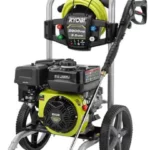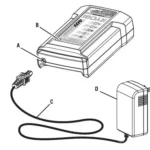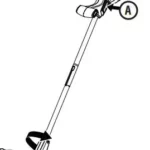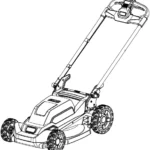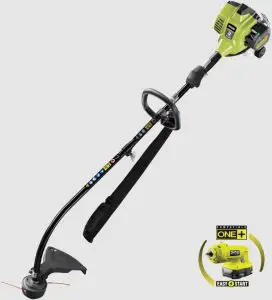
RYOBI RLT254CDSO 25.4CC 2 Stroke Easy Start Caurved Shaft Line Trimmer User Manual
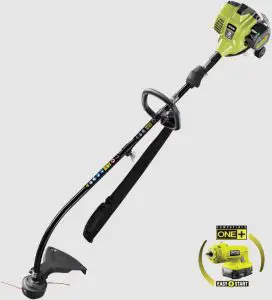
SYMBOLS
Important: Some of the following symbols may be used on your product. Please study them and learn their meaning.
Proper interpretation of these symbols will allow you to operate the product better and safer.
| – | Explanation |
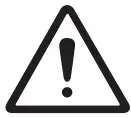 |
Safety alert |
 |
Read and understand all instructions before operating the product, follow all warnings and safety instructions. |
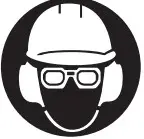 |
Wear eye, hearing and head protection when operating the product. |
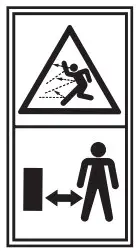 |
Beware of thrown or flying objects. Keep all bystanders, especially children and pets, at least 15 m away from the operating area |
 |
The product is not intended for use with a toothed saw type blade. |
 |
Do not use metal blade (s) on the product |
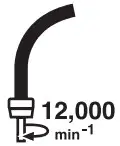 |
Rotational direction and maximum speed of the shaft for the cutting attachment. |
 |
Use unleaded gasoline intended for motor vehicle use with an octane rating of 91 ([R+M]/2) or higher. |
 |
Use full synthetic 2-stroke lubricant for air cooled engines. |
 |
Mix the fuel mix thoroughly and also each time before refuelling. |
 |
Keep hands away from blades. |
 |
Run position |
 |
Set the choke lever to “FULL” choke position. |
 |
Set the choke lever to “HALF” choke position. |
 |
Press the primer bulb 10 times. |
 |
Squeeze the throttle lock and throttle trigger to run. |
 |
Wait 10 seconds. |
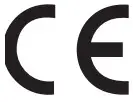 |
Conforms to all regulatory standards in the country in the EU where the product is purchased.. |
 |
EurAsian Conformity Mark |
 |
Ukrainian mark of conformity |
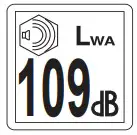 |
Guaranteed sound power level |
 |
Pull the starter rope. |
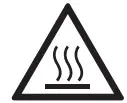 |
To reduce the risk of injury or damage, avoid contact with any hot surface. |
 |
Starting a warm engine by electrical starter |
 |
Starting a cold engine by electrical starter |
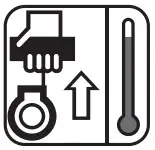 |
Starting a warm engine by hand |
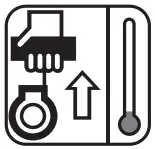 |
Starting a cold engine by hand |
The following signal words and meanings are intended to explain the levels of risk associated with the product.
| SYMBOLS | SIGNAL | MEANING |
 |
DANGER | Indicates an imminently hazardous situation, which, if not avoided, will result in death or serious injury. |
 |
WARNING | Indicates a potentially hazardous situation, which, if not avoided, could result in death or serious injury. |
 |
CAUTION | Indicates a potentially hazardous situation, which, if not avoided, may result in minor or moderate injury. |
 |
CAUTION | (Without Safety Alert Symbol) Indicates a situation that may result in property damage. |
Safety performance, and dependability have been given top priority in the design of your grass trimmer.
INTENDED USE
The grass trimmer is intended to be used only by adults who have read and understood the instructions and warnings in this manual and can be considered responsible for their actions. The product is only intended for use outdoors in a well ventilated area. For safety reasons, the product must be adequately controlled by using two-handed operation.
The product is designed for cutting grass, light weeds, and other similar vegetation at or about ground level.
The cutting plane should be approximately parallel to the ground surface.
The product should not be used to cut or trim hedges, bushes, or other vegetation where the cutting plane is not or about ground surface level.
Do not use the product for any other purpose.
WARNING
To reduce the risk of injury, the user must read and understand the operator’s manual.
WARNING
Do not attempt to operate the product until you have read thoroughly and understood completely all instructions and safety rules contained in this manual.
Failure to comply may result in accidents involving electric shock, fi re, and/or serious personal injury.
Save this operator’s manual and review frequently for continuing safe operation and instructing others who may use this product.
WARNING
The product is not intended to be used by children or persons with reduced physical, mental or sensory capabilities. Children should be adequately supervised to ensure they do not play with the product.
GENERAL SAFETY WARNINGS
- For safe operation, read and understand all instructions before using the product. Follow all safety instructions.
Failure to follow all safety instructions listed below, can result in serious personal injury. - Some regions have regulations that restrict the use of the product. Check with your local authority for advice.
- Do not allow children or untrained individuals to use the product.
- Never start or run the engine in a closed or poorly ventilated area; breathing exhaust fumes can kill.
- Clear the work area before each use. Remove all objects such as rocks, broken glass, nails, wire, or string that can be thrown or become entangled in the string head.
- Wear full eye and hearing protection while operating the product. If working in an area where there is a risk of falling objects, head protection must be worn.
- Hearing protection may restrict the operator’s ability to hear warning sounds. Pay particular attention to potential hazards around and inside the working area.
- Wear heavy long trousers, non-slip protective footwear, and gloves. Do not wear loose fitting clothing, short trousers, jewellery of any kind, or use with bare feet.
- Secure long hair so it is above shoulder level to prevent entanglement in any moving parts.
- Keep all bystanders, children, and pets at least 15 m away. Stop the product if anyone enters the area.
- Do not use the product when tired, ill, under medication, or under the influence of alcohol and drugs.
- Do not use in poor lighting. The operator needs clear unrestricted vision to identify potential hazards.
- Keep firm footing and balance at all times. Do not overreach. Overreaching can result in loss of balance or exposure to hot surfaces.
- Keep all parts of your body away from any moving part.
- Do not touch the area around the silencer or cylinder of the product, these parts get hot from operation.
- Always stop the engine and allow it to cool down before making any adjustments.
- Do not smoke when mixing the fuel or when filling the fuel tank.
- Mix and store the fuel in a container that is approved for fuel.
- Mix the fuel outdoors where there are no sparks or flames. Wipe up any fuel spillage. Move 9 m away from refueling site before starting engine.
- Stop the engine and allow to cool down before refueling or storing the product.
- Allow the engine to cool; empty the fuel tank and secure the product from moving before transporting in a vehicle.
- Always stop the engine and make sure all moving parts have come to stop before:
- servicing
- leaving the product unattended
- cleaning your product
- changing accessories
- clearing blockages
- checking for any damage after hitting an object
- checking for any damage if the product starts to vibrate abnormally
- performing maintenance
WARNING
Never use cutting means or attachments which are not specified by Ryobi in this manual. This includes the use of metal multi-piece pivoting chains and fl ail-blades.
These items are known to break up during use and present a high risk of serious injury to the operator or bystanders.
WARNING
Inspection after dropping or other impacts:
Thoroughly inspect the product and identify any affections or damage with it. Any part that is damaged should be properly repaired or replaced by an authorised service centre.
GRASS TRIMMER SAFETY WARNINGS
- Replace the string head if cracked, chipped, or damaged in any way. Be sure the string head is properly installed and securely fastened. Failure to do so can cause serious injury.
- Avoid using on wet grass.
- Do not walk backwards when using the product.
- Walk, never run.
- The small blade fitted to the cutting attachment guard is designed to trim the new extended line to the correct length for safe and optimum performance. It is very sharp; do not touch it, particularly when cleaning the product.
- Always ensure that ventilation openings are kept clear of debris.
- Before use and after any impact, check that there are no damaged parts. Examine the cutting means for signs of cracking or other damage. A defective switch or any part that is damaged should be properly repaired or replaced by an authorised service facility.
- Make sure the head attachment is properly installed and securely fastened.
- Make sure all guards, deflectors, handles, bolts, and fasteners are properly and securely attached.
- Do not modify the product in any way. This may increase the risk of injury to yourself or others.
- Use only the manufacturer’s replacement line in the cutting head. Do not use any other cutting attachment.
- Never operate the product without the cutting attachment guard in place and in good condition.
- Maintain a firm grip on both handles while trimming. Keep string head below waist level. Never cut with the string head located over 76 cm or more above the ground.
TRANSPORTATION AND STORAGE
- Stop the engine and allow it to cool down before storing or transporting.
- Clean all foreign materials from the product.
- Drain all fuel from tank into a container approved for petrol. Remember to properly replace and tighten the fuel cap.
- Run the engine until it stops, this will remove all fuel that could become stale and leave varnish and gum in the fuel system.
- Store the product in a cool, dry, and well-ventilated place that is inaccessible to children. Keep away from corrosive agents, such as garden chemicals and deicing salts. Do not store outdoors.
- When transporting the product in a vehicle, secure it against movement or falling to prevent injury to persons or damage to the product.
- Never carry or transport the product while the engine is running.
- Abide all government and local regulations for the safety storage and handling of petrol. Short term
- Stop the engine, and allow it to cool down before storing.
- Clean all foreign material from the product.
- Store the product in a cool, dry, and well-ventilated place that is inaccessible to children.
- Keep away from corrosive agents such as garden chemicals and de-icing salts.
- Do not store outdoors.
RESIDUAL RISKS
Even when the product is used as prescribed, it is still impossible to completely eliminate certain residual risk factors. The following hazards may arise in use and the operator should pay special attention to avoid the following:
- Injury caused by vibration
- Hold the product by designated handles and restrict working time and exposure.
- Exposure to noise can cause hearing injury
- Wear hearing protection and limit exposure.
- Eye injury due to flying debris
- Wear eye protection at all times.
RISK REDUCTION
It has been reported that vibrations from handheld tools may contribute to a condition called Raynaud’s syndrome.
Symptoms may include tingling, numbness and blanching of the fi ngers, usually apparent upon exposure to cold.
Hereditary factors, exposure to cold and dampness, diet, smoking and work practices are all thought to contribute to the development of these symptoms. There are measures that can be taken by the operator to possibly reduce the effects of vibration:
- Keep your body warm in cold weather. When operating the product, wear gloves to keep the hands and wrists warm. It is reported that cold weather is a major factor contributing to Raynaud’s Syndrome.
- After each period of operation, exercise to increase blood circulation.
- Ensure that the product is correctly located in a designated working position before operating the product.
- Take frequent work breaks. Limit the amount of exposure per day.
If you experience any of the symptoms of this condition, immediately discontinue use and see your physician.
WARNING
Injuries may be caused, or aggravated, by prolonged use of a tool. When using any tool for prolonged periods, ensure you take regular breaks.
KNOW YOUR PRODUCT
- Primer bulb
- Choke lever
- Fuel cap
- Starter grip
- Throttle lock
- Ignition switch
- Throttle trigger
- Rear handle
- Front handle
- Shaft
- Grass deflector
- String head
- Cutting line
- Idle speed screw
- Knob
- Hanger cap
- Bolt
- Wing nut
- Bump knob
- Lower housing
- Spool
- String guide
- Spring
- Nut
- Upper housing
- Air box cover
- Air filter
- Spark plug
- Metal spark plug boot
- Rubber protect boot
- Starter bit
- Switch button
- F/R button
- Electrical starter
- Starter bit shaft
- Lock button
- Guide recess
- Best cutting area
- Direction of cutter rotation
- Screw
- Mounting bracket
- Tab
- Slot
ASSEMBLY
UNPACKING
This product requires assembly.
- Carefully remove the tool and any accessories from the box. Make sure that all items listed in the packing list are included.
- Inspect the tool carefully to make sure no breakage or damage occurred during shipping.
- Do not discard the packing material until you have carefully inspected and satisfactorily operated the tool.
WARNING
If any parts are damaged or missing do not operate the product until the parts are replaced. Failure to heed this warning could result in serious personal injury.
WARNING
Do not attempt to modify the product or create accessories not recommended for use with the product.
Any such alteration or modification is misuse and could result in a hazardous condition leading to possible serious personal injury.
WARNING
To prevent accidental starting that could cause serious personal injury, always disconnect the engine spark plug wire from the spark plug when assembling parts.
WARNING
Never attach or adjust any attachment while power head is running. Failure to stop the engine may cause serious personal injury.
WARNING
Be certain all knobs and fasteners are fully tightened before operating the equipment. check it periodically for tightness during use to avoid serious injury.
PACKING LIST
- Trimmer
- Attachment shaft
- Front handle assembly
- Grass deflector
- Operator’s manual
- Figure sheet
ATTACHING THE FRONT HANDLE
- Loosen and remove the bolt and wing nut from the front handle.
- Install the front handle onto the upper shaft at the position between foam and warning label.
- Replace the bolt and wing nut and tighten wing nut securely
ATTACHING THE GRASS DEFLECTOR
- Insert the tab on the mounting bracket in the slot on the grass deflector.
- Insert the screw into the grass deflector.
- Tighten the screw securely.
ATTACHING THE POWER HEAD TO TRIMMER ATTACHMENT
WARNING
Never attach or adjust any attachment while power head is running. Failure to stop the engine may cause serious personal injury.
- The trimmer attachment connects to the power head by means of a coupler device.
- Loosen the knob on the coupler of the power head shaft and remove the end cap from the attachment.
- Push in the button located on the attachment shaft.
- Align the button with the guide recess on the power head coupler and slide the two shafts together.
- Rotate the attachment shaft until the button locks into the positioning hole.
NOTE: If the button does not release completely in the positioning hole, the shafts are not locked into place. Slightly rotate from side to side until the button is locked into place. - Tighten the knob securely
REMOVING THE ATTACHMENT FROM THE POWER HEAD
- Loosen the knob.
- Push in the button and twist the shafts to remove and separate the ends.
OPERATION
FUEL AND REFUELING HANDLING THE FUEL SAFELY
- Always handle fuel with care, it is highly flammable.
- Always refuel outdoors where there are no sparks and flames. Do not inhale fuel vapour. Do not smoke.
- Do not let petrol or lubricant come in contact with your skin.
- Keep petrol and lubricant away from the eyes. If petrol or lubricant comes in contact with the eyes, wash them immediately with clean water. If irritation is still present, see a doctor immediately.
- Clean up spilled petrol immediately.
- Always transport and store fuel in a container approved for petroleum.
MIXING THE FUEL
- This product is powered by a 2-stroke engine and requires pre-mixing petrol and 2-stroke lubricant. Premix unleaded petrol and 2-stroke engine lubricant in a clean container approved for petrol.
- This engine is certified to operate on unleaded petrol intended for motor vehicle use with an octane rating of 91 ([R + M]/2) or higher.
- Do not use any type of pre-mixed petrol / lubricant from fuel service stations, this includes the pre-mixed petrol /lubricant intended for use in mopeds, motorcycles, etc.
- Use synthetic 2-stroke lubricant only. Do not use automotive lubricant or 2-cycle outboard lubricant.
- Mix 2% synthetic 2-stroke lubricant into the petrol. This is a 50:1 ratio.
- Mix the fuel thoroughly and also each time before refuelling.
- Mix in small quantities. Do not mix quantities larger than usable in a 30-day period. A synthetic 2-stroke lubricant containing a fuel stabiliser is recommended.
FILLING THE TANK
WARNING
Check for fuel leaks. If any are found, correct them before using the saw to prevent fire or burn injury.
- Clean surface around fuel cap to prevent contamination.
- Loosen fuel cap slowly to release pressure and to keep fuel from escaping around the cap.
- Carefully pour fuel mixture into the tank. Avoid spillage.
- Prior to replacing the fuel cap, clean and inspect thegasket.
- Immediately replace fuel cap and hand tighten. Wipe up any fuel spillage. Move 9 m away from refuelling site before starting engine.
NOTE: It is normal for smoke to be emitted from a new engine during and after first use.
WARNING
Always shut off engine before fuelling. Never add fuel to a machine with a running or hot engine. Move at least 9 m from refuelling site before starting the engine. Do not smoke!
STARTING AND STOPPING
WARNING
Never start or run the engine inside a closed or poorly ventilated area; breathing exhaust fumes can kill.
TO START A COLD ENGINE:
NOTE: Lay the product on the ground. Ensure the cutting means will not contact anything when it starts to rotate.
- Press the primer bulb 10 times.
NOTE: After the 7th press, the fuel should be visible in the primer bulb. If not, continue pressing until the fuel is visible. - Set the choke lever to choke position.
- Hold down the throttle lock and then squeeze the throttle trigger. Keep the throttle trigger squeezed completely following steps 3 to 7. Pull the starter grip until the engine attempts to start. Do not pull the starter grip more than 4 times.
- Set the choke lever to choke position.
- Pull the starter grip until the engine starts. Do not pull the starter grip more than 6 times.
NOTE: If the engine does not start, repeat the procedure from step 2. - Allow the engine to run for 10 seconds.
- Set the choke lever to position.
TO START A WARM ENGINE:
- Press the primer bulb 10 times.
- Set the choke lever to choke position.
- Hold down the throttle lock and then squeeze the throttle trigger completely and pull the starter grip until the engine starts. Do not pull the starter grip more than 6 times.
STARTING THE ENGINE USING AN ELECTRICAL STARTER (OPTIONAL):
WARNING
Only use the Ryobi OES18 electrical starter. Use of anyother starter may damage the engine and cause serious personal injury
WARNING
Before using the electrical starter to start the product, please read and understand completely the operation manual of the OES18 electrical starter to avoid improper operation and serious personal injury.
TO START A COLD ENGINE BY ELECTRICAL STARTER:
- Install the starter bit into the electrical starter with the pentagon bit facing outside.
- Push the F/R button to the left until the pentagon symbol shows on the F/R button.
- Lay the product on the ground and make sure that the cutting means do not come in contact with anything.
- Press the primer bulb 10 times.
NOTE: After the 7th press, the fuel should be visible in the primer bulb. If not, continue pressing until the fuel is visible. - Set the choke lever to choke position.
- Hold down the throttle lock and then squeeze the throttle trigger completely with your left hand and keep the throttle trigger squeezed completely throughsteps 6 to 12.
- Use your right hand to put the starter bit shaft to the shaft hole on the engine. Make sure the starter bit is properly engaged.
NOTE: The electrical starter is equipped with a safety interlock. Do not press and hold on the switch button when putting the electrical starter shaft into the shaft hole on the engine, otherwise the starter will not turn.
The starter will not turn if the electrical starter is not properly engaged. - Press and hold the electrical starter switch button until the engine attempts to start. Do not press the electrical starter for more than 4 seconds.
- Set the choke lever to choke position.
- Press and hold the electrical starter switch button until the engine starts.
NOTE: If the engine does not start, repeat the procedure from step 5. Do not repeat the procedure more than 1 time. If the engine does not start after the second attempt, see the solution instruction for the
“Flooded engine” in the “Troubleshooting” section of this manual. - Allow the engine to warm up for 10 seconds.
- Set the choke level to choke position
TO START A WARM ENGINE BY ELECTRICAL STARTER:
- Install the starter bit into the electrical starter with the pentagon bit facing outside.
- Push the F/R button to the left until the pentagon symbol shows on the F/R button.
- Lay the product on the ground and make sure that the cutting means do not come in contact with anything.
- Press the primer bulb 10 times.
- Set the choke lever to position.
- Hold down the throttle lock and then squeeze the throttle trigger completely with your left hand and keep the throttle trigger squeezed completely. Use the right hand to put the electrical starter shaft into the shaft hole on the engine. Make sure the starter is properly engaged.
- Press and hold the electrical starter switch button until the engine starts.
NOTE: If the engine does not start, repeat the procedure from step 5. Do not repeat the procedure more than 1 time. If the engine does not start after the second attempt, see the solution instruction for the “Flooded engine” in the “Troubleshooting” section of this manual.
TO STOP THE ENGINE:
- Set the switch to the “O” (OFF) position
OPERATING THE GRASS TRIMMER
Hold the product with the right hand on the rear handle and the left hand on the front handle. Keep a firm grip with both hands while in operation. The product should be held at a comfortable position with the trigger handle about hip height.
Always operate the product at full throttle. Prolonged cutting at partial throttle will result in lubricant dripping from the silencer. Cut tall grass from the top down. This will prevent grass from wrapping around the shaft housing and bump head which may cause damage from overheating. If grass becomes wrapped around the bump head, stop the engine, and remove the grass.
CUTTING TIPS
- Avoid hot surfaces by always keeping the tool away from your body. (Proper operating position shown in figure 5.)
- Keep the product tilted toward the area being cut; this is the best cutting area.
- The product cuts when passing the product from right to left. This will avoid throwing debris at the operator. Avoid cutting in the dangerous area shown in illustration.
- Use the tip of the string to do the cutting; do not force the string head into the uncut grass.
- Wire and picket fences cause extra string wear, even breakage.
- Stone and brick walls, kerbs and wood may wear string rapidly.
- Avoid trees and shrubs. Tree bark, wood mouldings, cladding and fence posts can be easily damaged by the string.
ADVANCING THE LINE
Line advance is controlled by tapping the string head on grass while running engine at full throttle.
- Run engine at full throttle.
- Tap the knob on ground to advance string. The string advances each time the head is tapped. Do not hold the knob on the ground.
NOTE: The line trimming cut-off blade on the grass deflector will cut the line to the correct length.
NOTE: If the string is worn too short, you may not be able to advance the string by tapping it on the ground. If so, stop the engine, and manually advance the line.
ADVANCING THE CUTTING LINE MANUALLY
- Stop the engine.
- Push the knob in while pulling on string(s) to manually advance the line.
MAINTENANCE
WARNING
Use only original manufacturer’s replacement parts, accessories and attachments. Failure to do so can cause possible injury, poor performance and may void your warranty.
- Always stop the engine and allow it cool before making any maintenance.
- You may make adjustments and repairs described in this user manual. For other repairs, contact the authorized service agent.
- Consequences of improper maintenance may include excess carbon deposits resulting in loss of performance and discharge of black oily residue dripping from the silencer.
- For replacement line, use only nylon filament line of the diameter described in the specification table of this manual.
- After extending new cutter line, always return the product to its normal operating position before starting.
- The cutting attachment must not work in idle mode. If this requirement is not satisfied, the clutch has to be adjusted or the machine needs an urgent maintenance by a qualified technician.
- After each use, clean the product with a soft dry cloth.
- Check all nuts, bolts and screws at frequent intervals for proper tightness to ensure the product is in safe working condition. Any part that is damaged should be properly repaired or replaced by an authorised service centre.
Maintenance schedule
| Check if fastener is fully tightened | Before each use |
| Check: Cutting attachment must not rotate in idle mode ² | Before each use |
| Check fuel hose | Before each use |
| Check all hose connections | Before each use |
| Clean fuel tank and filter 1 | Every 3 months or 50 hours of operation |
| Replace fuel filter 1 | Every year or after 300 hours or operation |
| Check fuel cap or fuel tank vapor vent (if equipped) for leakage | Before each use |
| Clean air filter | Every 25 hours |
| Change air filter | Every year or after 300 hours or operation |
| Clean or adjust spark plug | Every 6 months or 100 hours of operation |
| Replace spark plug | Every year or after 300 hours or operation |
| Clean spark arrestor | Every 25 hours |
| Replace spark arrestor | Every year or after 300 hours or operation |
| Clean the exhaust port and silencer | Every 25 hours |
- These items should only be carried out by an authorised service centre.
- If this requirement is not met, contact an authorised service centre for repair or adjustment.
STRING HEAD REPLACEMENT
- Stop the engine.
- Align the spanner along both flat side of arbor flange washer.
- Turn the string head counterclockwise by hand to remove old one.
- Replace a new string head, align the nut in the string head to the connector shaft of lower boom.
- Turn the string head clockwise by hand to tighten, recommended torque is 6 N.M.
LINE REPLACEMENT
- Ensure the product is in the off position.
- Use a 2.4 mm diameter monofilament string.
- Stop the engine.
- Cut one piece of string approximately 6 m in length.
- Rotate the bump knob clockwise as necessary to align the arrows on the bump knob with the arrows on the lower housing of string head.
- Insert one end of the string into the eyelet located on the side of the string head and push until string comes out through eyelet on the other side.
- Continue to push string through the string head until the middle section of the string is inside the string head and string outside the string head is evenly divided on each side.
- Rotate the knob on the string head clockwise to wind the line.
- Wind the string until approximately 20 cm remains protruding from the string head.
CLEANING THE EXHAUST PORT AND MUFFLER
Depending on the type of fuel used, the type and amount of lubricant used, and/or your operating conditions, the exhaust port and silencer may become blocked with carbon deposits. If you notice a power loss with your gas powered tool, a qualified service technician will need to remove these deposits to restore performance.
SPARK ARRESTOR
The spark arrestor must be cleaned or replaced every 25 hours to ensure proper performance of your product. Spark arrestors may be in different locations depending on the model purchased. Please contact your nearest service dealer for the location of the spark arrestor for your model.
CLEANING THE AIR FILTER
For proper performance and long life, keep the air filter clean.
- Ensure the product is in the off position.
- Remove the air filter cover.
- Remove the air filter and clean it with warm soapy water.
- Rinse, and let the air filter dry completely.
- Work two drops of lubricant into the air filter.
- Replace the air filter (fits only one way).
- Replace the air filter cover.
NOTE: The filter should be replaced annually for best performance.
FUEL CAP
WARNING
A leaking fuel cap is a fi re hazard and must be replaced immediately
The fuel cap contains a non-serviceable filter and a check valve. A clogged fuel filter will cause poor engine performance. If performance improves when the fuel cap is loosened, check valve may be faulty or filter clogged.
SPARK PLUG REPLACEMENT
WARNING
The material of the spark plug is metal. It becomes very hot after you stop the engine. Wait for the engine to cool down before disassembling the metal spark plug boot to avoid personal injury.
NOTE: This engine uses a Champion RCJ-6Y or equivalent with 0.63 mm (0.025 in.) electrode gap. Use an exact replacement and replace annually.
- Stop the engine.
- Hold the front portion of the rubber protect boot and pull it away from the housing.
- Pull the rubber protect boot upward to release the hook.
- Twist the metal spark plug boot and pull it away from the spark plug.
- Loosen the spark plug by turning it counter clockwise with a wrench. Remove the old spark plug and replace with a new one. Assemble back the metal spark plugboot and the rubber protect boot.
ATTACHING THE HANGER CAP
To use the hanger cap, push in the button and place the hanger cap over the lower end of the attachment. Slightly rotate the cap from side to side until the button locks into place.
NOTE: The secondary hole in the attachment shaft can be used for hanging purposes as well.
TROUBLESHOOTING
IF THESE SOLUTIONS DO NOT SOLVE THE PROBLEM, CONTACT YOUR AUTHORISED SERVICE DEALER
| PROBLEM | POSSIBLE CAUSE | SOLUTION |
| Engine will not start. |
|
|
| Engine starts but will not accelerate. | Engine requires approximately three minutes to warm up. | Allow engine to completely warm up. If engine does not accelerate after three minutes, contact a servicing dealer. |
| Engine starts but will only run at high speed at half choke. | Carburetor requires adjustment. | Contact a servicing dealer. |
| Engine does not reach full speed and emits excessive smoke. |
|
|
